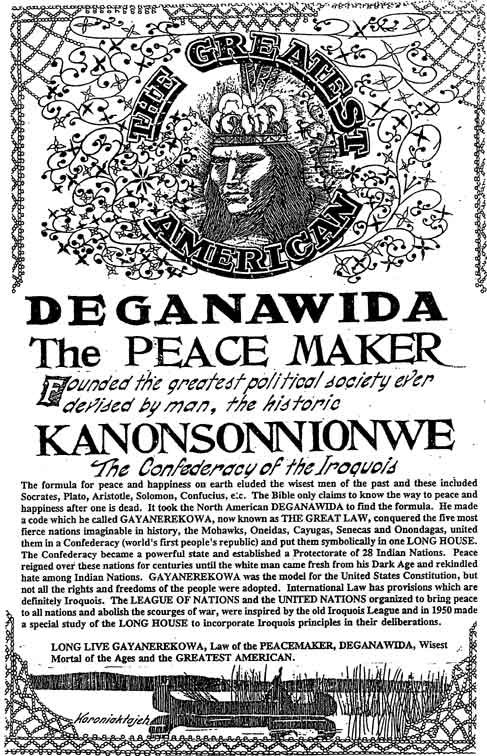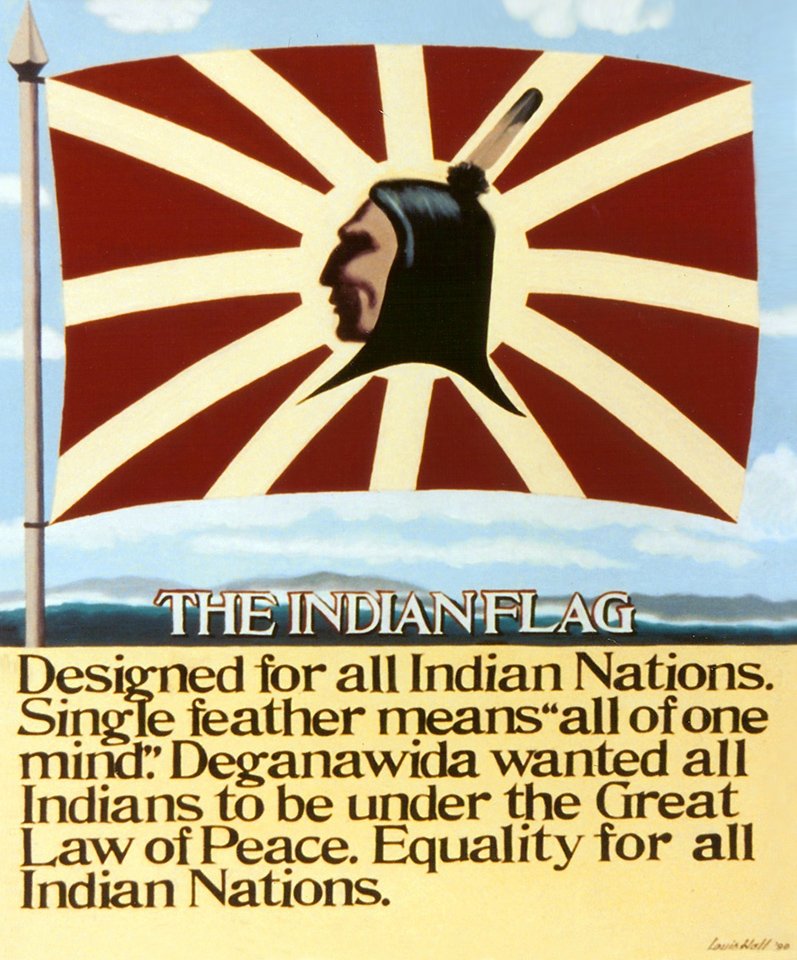The great goodness is already here
Courtesy: Karoniaktajeh Louis Hall
Story told by Tekarontake
The Great Law of Peace: that’s somebody’s mumbled up translation.
Kaianere’kó:wa, that’s what we call it. Ká:ien means it’s here. Ioiánere’ means it’s good. Kó:wa means it’s great. The great goodness, it’s already here. It’s for us to utilize and work with.
That’s Kaianere’kó:wa.
When guys started using those translations, they were already being colonized.
“Well, he was the one. He spoke our language and he’s the one that wrote this and that.”
I don’t give a shit. Why do you say he could write and read and everything else? Where was he educated?
When he comes back from his education, what makes him different from the white anthropologist? They’re both coming, and they’re talking to people. Sure, he knows the language. But he doesn’t think in the language. Now he’s coming to people that think in the language. They’re not English speakers, and they’re trying their best to explain things.
So, they’re trying to find comparisons with their system. And so they’re using their words to try to define what ours are. It just created a big dish of spaghetti, you don’t know where the truth began and where it ends.
Ó:nen ken’ ká:ien ne kaianere’kó:wa
Courtesy: Karoniaktajeh Louis Hall
Tekarontake roká:raton
The great law of peace: nè:’e ne ónhka’k teioni’tón:ni tsi ní:tsi teiakowennanetáhkwen.
Kaianere’kó:wa, né: ní: iakwana’tónhkhwa’. Ká:ien kén:ton tsi ken’ ká:ien. Ioiánere’, kén:ton tsi ioiánere’. Kó:wa kén:ton tsi kowá:nen. Kaianere’kó:wa, ó:nen ken’ ká:ien. Né: aó:wen naiákwatste’.
Nè:’e ne Kaianere’kó:wa.
Shontahontáhsawen’ ne tho ní:tsi tahatiwennanetáhko’, ó:nen tontáhsawen’ wa’thonwati’nikonhraté:ni’.
“Ráonha ki’ nen’ nè:’e, rahrónhkhahkwe’ nonkwawén:na tánon’ ráonha shohiá:ton thí:ken nahò:ten’.”
Iah thé: tekatkonseratsterístha’. Oh nontié:ren tsi ión:ton enwá:ton’ enhahiá:ton’ tánon’ enhawennahnó:ten’ tánon’ akwé:kon ki’ tsi nahò:ten’? Ka’ nón: nihoterihwaiénston?
Nó:nen ténthre’ tsi nón: nihoterihwaienstahnónhne’, oh na’tehiattíhen ne renhnarà:ken anthropolgist? Tehnitsá:ron tehnikwáthos, tánon’ onkwe’shòn:’a tehotíhthare. Kanekhé:re tsi rahrónkha’ nowén:na. Nek tsi iah tehanonhtónnion ne onkwehonwehnéha kawennontáhkwen. Ó:nen tahshakotken’sè:re’ nonkwe’shòn:’a tsi iononhtónnion ne onkwehonwehnéha kawennontáhkwen. Iah Tiohrhèn:sha tehotiwenna’ón:we, tánon’ ronahkwíhsron se’ ahati’nikonhraién:tahte’ tsi nahò:ten’.
Né: ká:ti’, ronte’niéntha’ ahatitshén:ri’ ahoti’nikonhraién:ta’ne’ ne ronónha tsi nihotirihò:ten’, nek ne ronónha nahò:ten’ ronaterièn:tare, nok iah teiónhnhe’ raotiwén:na tsi ní:ioht ní: onkwawén:na. Tánon’ rontewennátstha’ ronónha raotiwenna’shòn:’a ahonte’nién:ten’ ahonthrória’te’ nahò:ten’ kén:tons né:ne í: onkwawenna’shòn:’a. Kwah nek tha’tewani’tón:ni’, iah tesaterièn:tare tsi nón: nitiotáhsawe ne tó:kenske nok tsi nón: niwatò:ktha’.
Edited by: Simona Rosenfield, Local Journalism Initiative Reporter
Translation by Sahawisó:ko’ Arquette


